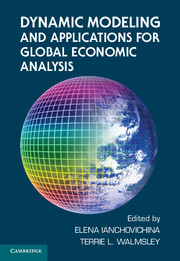Book contents
- Frontmatter
- Contents
- Contributors
- Acknowledgments
- PART I INTRODUCTION AND OVERVIEW
- PART II STRUCTURE OF THE DYNAMIC GTAP FRAMEWORK
- 2 Theoretical Structure of Dynamic GTAP
- 3 Behavioral and Entropy Parameters in the Dynamic GTAP Model
- 4 An Overview of the Dynamic GTAP Data Base: The Data Base Construction and Aggregation Programs
- 5 A Baseline Scenario for the Dynamic GTAP Model
- 6 Welfare Analysis in the Dynamic GTAP Model
- 7 Implementing the Dynamic GTAP Model in the RunDynam Software
- PART III APPLICATIONS OF DYNAMIC GTAP
- PART IV EVALUATION OF THE DYNAMIC GTAP FRAMEWORK
- Appendix: Negative Investment: Incorporating a Complementarity into the Dynamic GTAP Model
- Glossary of GDyn Notation
- Index
- References
5 - A Baseline Scenario for the Dynamic GTAP Model
Published online by Cambridge University Press: 05 June 2012
- Frontmatter
- Contents
- Contributors
- Acknowledgments
- PART I INTRODUCTION AND OVERVIEW
- PART II STRUCTURE OF THE DYNAMIC GTAP FRAMEWORK
- 2 Theoretical Structure of Dynamic GTAP
- 3 Behavioral and Entropy Parameters in the Dynamic GTAP Model
- 4 An Overview of the Dynamic GTAP Data Base: The Data Base Construction and Aggregation Programs
- 5 A Baseline Scenario for the Dynamic GTAP Model
- 6 Welfare Analysis in the Dynamic GTAP Model
- 7 Implementing the Dynamic GTAP Model in the RunDynam Software
- PART III APPLICATIONS OF DYNAMIC GTAP
- PART IV EVALUATION OF THE DYNAMIC GTAP FRAMEWORK
- Appendix: Negative Investment: Incorporating a Complementarity into the Dynamic GTAP Model
- Glossary of GDyn Notation
- Index
- References
Summary
Introduction
The development of a baseline scenario is an important component of assessing the impact of a policy issue with a dynamic model. A baseline depicts how the world economy might be expected to change, over a given period of time, if the policy were not implemented. The baseline scenario should therefore reflect as closely as possible the changes expected to occur in the world economy, excluding the particular policy of interest.
The components of the baseline will depend on the regional/sectoral aggregation chosen for the study and the policy being examined. A good baseline will include projections for macroeconomic variables – such as real GDP, population, technological change, and primary factor growth rates – for each of the regions being examined, as well as key policies that have already been agreed on or are expected to affect the regions/sectors or the policy scenario being examined. New baselines are often developed each time a new policy issue is addressed. For example, a baseline built to examine China's accession to the WTO will not be suitable for examining the impact of free trade agreements within Southern Africa, most notably because the regional aggregation will differ between the two simulations but also because the policies we would want to include in the baseline would differ considerably.
- Type
- Chapter
- Information
- Dynamic Modeling and Applications for Global Economic Analysis , pp. 136 - 157Publisher: Cambridge University PressPrint publication year: 2012
References
- 7
- Cited by



